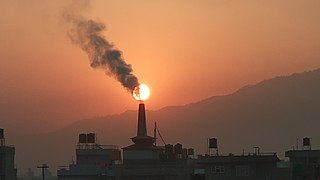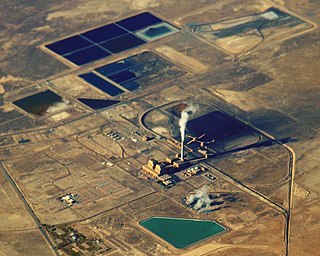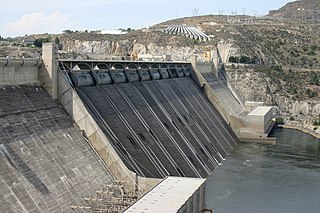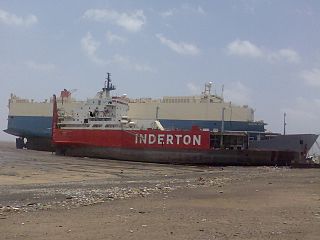 W
WWaste are unwanted or unusable materials. Waste is any substance which is discarded after primary use, or is worthless, defective and of no use. A by-product by contrast is a joint product of relatively minor economic value. A waste product may become a by-product, joint product or resource through an invention that raises a waste product's value above zero.
 W
WAbandoned footwear, such as a lone boot or shoe, has often been noted in out-of-the-way places like ponds or by the side of roads. Sometimes the shoes may even be new and fashionable.
 W
WAn animal product is any material derived from the body of an animal. Examples are fat, flesh, blood, milk, eggs, and lesser known products, such as isinglass and rennet.
 W
WBiodegradable waste includes any organic matter in waste which can be broken down into carbon dioxide, water, methane or simple organic molecules by micro-organisms and other living things by composting, aerobic digestion, anaerobic digestion or similar processes. In waste management, it also includes some inorganic materials which can be decomposed by bacteria. Such materials include gypsum and its products such as plasterboard and other simple organic sulfates which can decompose to yield hydrogen sulphide in anaerobic land-fill conditions.
 W
WBottom ash is part of the non-combustible residue of combustion in a power plant, boiler, furnace or incinerator. In an industrial context, it has traditionally referred to coal combustion and comprises traces of combustibles embedded in forming clinkers and sticking to hot side walls of a coal-burning furnace during its operation. The portion of the ash that escapes up the chimney or stack is, however, referred to as fly ash. The clinkers fall by themselves into the bottom hopper of a coal-burning furnace and are cooled. The above portion of the ash is also referred to as bottom ash.
 W
WChaff is the dry, scaly protective casing of the seeds of cereal grains, or similar fine, dry, scaly plant material such as scaly parts of flowers, or finely chopped straw. Chaff is indigestible by humans, but livestock can eat it and in agriculture it is used as livestock fodder, or is a waste material ploughed into the soil or burned.
 W
WChat is fragments of siliceous rock, limestone, and dolomite waste rejected in the lead-zinc milling operations that accompanied lead-zinc mining in the first half of the 20th century. Historic lead and zinc mining in the Midwestern United States was centered in two major areas: the tri-state area covering more than 2,500 square miles (6,500 km2) in southwestern Missouri, southeastern Kansas, and northeastern Oklahoma and the Old Lead Belt covering about 110 square miles (280 km2) in southeastern Missouri. The first recorded mining occurred in the Old Lead Belt in about 1742. The production increased significantly in both the tri-state area and the Old Lead Belt during the mid-19th century and lasted up to 1970.
 W
WChemical waste is a waste that is made from harmful chemicals. Chemical waste may fall under regulations such as COSHH in the United Kingdom, or the Clean Water Act and Resource Conservation and Recovery Act in the United States. In the U.S., the Environmental Protection Agency (EPA) and the Occupational Safety and Health Administration (OSHA), as well as state and local regulations also regulate chemical use and disposal. Chemical waste may or may not be classed as hazardous waste.
 W
WClinker is a general name given to waste from industrial processes, particularly those that involve smelting metals, welding, burning fossil fuels and use of a blacksmith's forge, which commonly causes a large buildup of clinker around the tuyere. Clinker often forms a loose, dark deposit consisting of waste materials such as coke, coal, slag, charcoal, and grit. Clinker often has a glassy look to it, usually because of the formation of molten silica compounds during processing. Clinker generally is much denser than coke, and, unlike coke, generally contains too little carbon to be of any value as fuel.
 W
WFly ash, flue ash, coal ash, or pulverised fuel ash (in the UK) – plurale tantum: coal combustion residuals (CCRs) – is a coal combustion product that is composed of the particulates (fine particles of burned fuel) that are driven out of coal-fired boilers together with the flue gases. Ash that falls to the bottom of the boiler's combustion chamber (commonly called a firebox) is called bottom ash. In modern coal-fired power plants, fly ash is generally captured by electrostatic precipitators or other particle filtration equipment before the flue gases reach the chimneys. Together with bottom ash removed from the bottom of the boiler, it is known as coal ash. Depending upon the source and composition of the coal being burned, the components of fly ash vary considerably, but all fly ash includes substantial amounts of silicon dioxide (SiO2) (both amorphous and crystalline), aluminium oxide (Al2O3) and calcium oxide (CaO), the main mineral compounds in coal-bearing rock strata.
 W
WCoal combustion products (CCPs), also called coal combustion wastes (CCWs) or coal combustion residuals (CCRs), are categorized in four groups, each based on physical and chemical forms derived from coal combustion methods and emission controls:
 W
WConstruction waste or debris is any kind of debris from the construction process. Different government agencies have clear definitions. For example, the United States Environmental Protection Agency EPA defines construction and demolition materials as “debris generated during the construction, renovation and demolition of buildings, roads, and bridges.”
 W
WDemolition waste is waste debris from destruction of buildings, roads, bridges, or other structures. Debris varies in composition, but the major components, by weight, in the US include concrete, wood products, asphalt shingles, brick and clay tile, steel, and drywall. There is the potential to recycle many elements of demolition waste.
 W
WDirt is unclean matter, especially when in contact with a person's clothes, skin or possessions. In such case they are said to become dirty. Common types of dirt include:Dust: a general powder of organic or mineral matter Filth: foul matter such as excrement Grime: a black, ingrained dust such as soot Soil: the mix of clay, sand, and humus which lies on top of bedrock. The term 'soil' may be used to refer to unwanted substances or dirt that are deposited onto surfaces such as clothing.
 W
WDust bunnies are small clumps of dust that form under furniture and in corners that are not cleaned regularly. They are made of hair, lint, dead skin, spider webs, dust and sometimes light rubbish and debris and are held together by static electricity and felt-like entanglement. They can house dust mites or other parasites and can lower the efficiency of dust filters by clogging them. The movement of a single large particle can start the formation of a dust bunny.
 W
WFly ash, flue ash, coal ash, or pulverised fuel ash (in the UK) – plurale tantum: coal combustion residuals (CCRs) – is a coal combustion product that is composed of the particulates (fine particles of burned fuel) that are driven out of coal-fired boilers together with the flue gases. Ash that falls to the bottom of the boiler's combustion chamber (commonly called a firebox) is called bottom ash. In modern coal-fired power plants, fly ash is generally captured by electrostatic precipitators or other particle filtration equipment before the flue gases reach the chimneys. Together with bottom ash removed from the bottom of the boiler, it is known as coal ash. Depending upon the source and composition of the coal being burned, the components of fly ash vary considerably, but all fly ash includes substantial amounts of silicon dioxide (SiO2) (both amorphous and crystalline), aluminium oxide (Al2O3) and calcium oxide (CaO), the main mineral compounds in coal-bearing rock strata.
 W
WFood loss and waste is food that is not eaten. The causes of food waste or loss are numerous and occur throughout the food system, during production, processing, distribution, retail and consumption. Overall, about one third of the world's food is thrown away.
 W
WGarbage, trash, rubbish, or refuse is waste material that is discarded by humans, usually due to a perceived lack of utility. The term generally does not encompass bodily waste products, purely liquid or gaseous wastes, nor toxic waste products. Garbage is commonly sorted and classified into kinds of material suitable for specific kinds of disposal.
 W
WGreen waste, also known as "biological waste", is any organic waste that can be composted. It is most usually composed of refuse from gardens such as grass clippings or leaves, and domestic or industrial kitchen wastes. Green waste does not include things such as dried leaves, pine straw, or hay. Such materials are rich in carbon and considered "brown wastes," while green wastes contain high in concentrations of nitrogen. Green waste can be used to increase the efficiency of many composting operations and can be added to soil to sustain local nutrient cycling.
 W
WIndustrial waste is the waste produced by industrial activity which includes any material that is rendered useless during a manufacturing process such as that of factories, mills, and mining operations. Types of industrial waste include dirt and gravel, masonry and concrete, scrap metal, oil, solvents, chemicals, scrap lumber, even vegetable matter from restaurants. Industrial waste may be solid, semi-solid or liquid in form. It may be hazardous waste or non-hazardous waste. Industrial waste may pollute the nearby soil or adjacent water bodies, and can contaminate groundwater, lakes, streams, rivers or coastal waters. Industrial waste is often mixed into municipal waste, making accurate assessments difficult. An estimate for the US goes as high as 7.6 billion tons of industrial waste produced annually, as of 2017. Most countries have enacted legislation to deal with the problem of industrial waste, but strictness and compliance regimes vary. Enforcement is always an issue.
 W
WMarine debris, also known as marine litter, is human-created waste that has deliberately or accidentally been released in a sea or ocean. Floating oceanic debris tends to accumulate at the center of gyres and on coastlines, frequently washing aground, when it is known as beach litter or tidewrack. Deliberate disposal of wastes at sea is called ocean dumping. Naturally occurring debris, such as driftwood and drift seeds, are also present.
 W
WMunicipal solid waste (MSW), commonly known as trash or garbage in the United States and rubbish in Britain, is a waste type consisting of everyday items that are discarded by the public. "Garbage" can also refer specifically to food waste, as in a garbage disposal; the two are sometimes collected separately. In the European Union, the semantic definition is 'mixed municipal waste,' given waste code 20 03 01 in the European Waste Catalog. Although the waste may originate from a number of sources that has nothing to do with a municipality, the traditional role of municipalities in collecting and managing these kinds of waste have produced the particular etymology 'municipal.'
 W
WPackaging waste, the part of the waste that consists of packaging and packaging material, is a major part of the total global waste, and the major part of the packaging waste consists of single-use plastic food packaging, a hallmark of throwaway culture. Notable examples for which the need for regulation was recognized early, are "containers of liquids for human consumption", i.e. plastic bottles and the like. In Europe, the Germans top the list of packaging waste producers with more than 220 kilos of packaging per capita.
 W
WPepe may refer to secondhand clothes that are commonly worn by its population in Haiti. These clothes are usually sent from the United States. The Haitian textile industry has suffered due to the widespread popularity of pepe. There have even been discussions about banning the import of pepe. However, this is unlikely since the general population continues to wear pepe, which include many brand names that otherwise would be inaccessible.
 W
WPost-consumer waste is a waste type produced by the end consumer of a material stream; that is, where the waste-producing use did not involve the production of another product.
 W
WRed mud, formally termed bauxite residue, is an industrial waste generated during the processing of bauxite into alumina using the Bayer process. It is composed of various oxide compounds, including the iron oxides which give its red colour. Over 95% of the alumina produced globally is through the Bayer process; for every tonne of alumina produced, approximately 1 to 1.5 tonnes of red mud are also produced. Annual production of alumina in 2020 was over 133 million tonnes resulting in the generation of over 175 million tonnes of red mud.
 W
WThe Sanitary Garden or Kala Sagar is an art exhibition in Chandigarh, India consisting of sculptures made from toilets and other sanitary items.
 W
WSawdust is a by-product or waste product of woodworking operations such as sawing, sanding, milling, planing, and routing. It is composed of small chippings of wood. These operations can be performed by woodworking machinery, portable power tools or by use of hand tools. Wood dust is also the byproduct of certain animals, birds and insects which live in wood, such as the woodpecker and carpenter ant. In some manufacturing industries it can be a significant fire hazard and source of occupational dust exposure.
 W
WSea balls are tightly packed balls of fibrous marine material, recorded from the seashore. They vary in size but are generally up to 7 centimetres (2.8 in) in size. In Edgartown, Massachusetts a longish sea ball around 45 centimetres (18 in) in diameter has been found. Others have been reported at Dingle Bay in Ireland. They may occur in hundreds and are composed of plant material, in majority seagrass rhizome netting torn out by water movement.
 W
WA ship graveyard or ship cemetery is a location where the hulls of scrapped ships are left to decay and disintegrate, or left in reserve. Such a practice is now less common due to waste regulations and so some dry docks where ships are broken are also known as ship graveyards.
 W
WA spoil tip is a pile built of accumulated spoil – waste material removed during mining. These waste materials are typically composed of shale, as well as smaller quantities of carboniferous sandstone and other residues. Spoil tips are not formed of slag, but in some areas, such as England and Wales, they are referred to as slag heaps. In Scotland the word bing is used.
 W
WIn mining, tailings are the materials left over after the process of separating the valuable fraction from the uneconomic fraction (gangue) of an ore. Tailings are distinct from overburden, which is the waste rock or other material that overlies an ore or mineral body and is displaced during mining without being processed.
 W
WToxic waste is any unwanted material in all forms that can cause harm. Many of today's household products such as televisions, computers and phones contain toxic chemicals that can pollute the air and contaminate soil and water. Disposing of such waste is a major public health issue.
 W
WTrash Inc: The Secret Life of Garbage is a one-hour television documentary film that aired on CNBC on September 29, 2010 about trash/garbage, what happens to it when it's "thrown away", and its impact on the world. The film is hosted by CNBC Squawk Box co-anchor Carl Quintanilla as he reports from various landfills, business, and other locations in the United States and China.
 W
WUsed goods mean any item of personal property offered for sale not as new, including metals in any form except coins that are legal tender, but excluding books, magazines, and postage stamps.
 W
WWaste heat is heat that is produced by a machine, or other process that uses energy, as a byproduct of doing work. All such processes give off some waste heat as a fundamental result of the laws of thermodynamics. Waste heat has lower utility than the original energy source. Sources of waste heat include all manner of human activities, natural systems, and all organisms, for example, incandescent light bulbs get hot, a refrigerator warms the room air, a building gets hot during peak hours, an internal combustion engine generates high-temperature exhaust gases, and electronic components get warm when in operation.
 W
WWaste House is a building on the University of Brighton campus in the centre of Brighton on the south coast of England. It was built between 2012 and 2014 as a project involving hundreds of students and apprentices and was designed by Duncan Baker-Brown, an architect who also lectures at the university. The materials consist of a wide range of construction industry and household waste—from toothbrushes and old jeans to VHS cassettes and bicycle inner tubes—and it is the first public building in Europe to be built primarily of such products. "From a distance [resembling] an ordinary contemporary town house", Waste House is designed to be low-energy and sustainable, and will be in continuous use as a test-bed for the university's design, architecture and engineering students. The building has won several awards and was shortlisted for the Royal Institute of British Architects' Stephen Lawrence Prize in September 2015.
 W
WWhitechapel Mount was a large artificial mound of disputed origin. A prominent landmark in 18th century London, it stood in the Whitechapel Road beside the newly constructed London Hospital, being not only older, but significantly taller. It was crossed by tracks, served as a scenic viewing-point, could be ascended by horses and carts, and supported some trees and formal dwelling-houses. It has been interpreted as: a defensive fortification in the English Civil War; a burial place for victims of the Great Plague; rubble from the Great Fire of London; and as a laystall. Possibly all of these theories are true to some extent.
 W
WWood ash is the powdery residue remaining after the combustion of wood, such as burning wood in a fireplace, bonfire, or an industrial power plant. It is largely composed of calcium compounds along with other non-combustible trace elements present in the wood. It has been used for many purposes throughout history.
 W
WZero waste agriculture is a type of sustainable agriculture which optimizes use of the five natural kingdoms, i.e. plants, animals, bacteria, fungi and algae, to produce biodiverse-food, energy and nutrients in a synergistic integrated cycle of profit making processes where the waste of each process becomes the feedstock for another process.